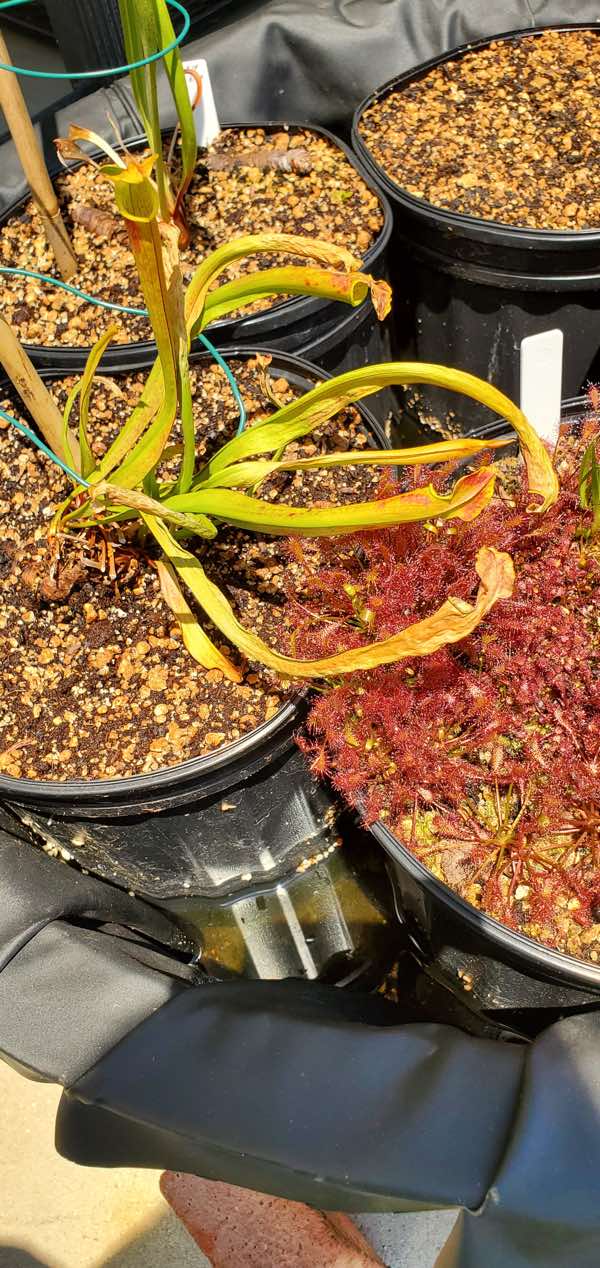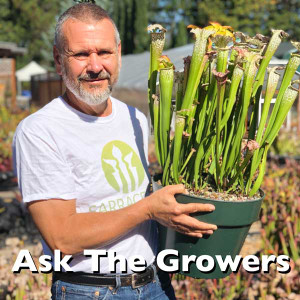July 16, 2023
Q/A 124 - Sudden Die Off of Sarracenia
QUESTION:
I've had an issue recently with a sudden collapse of Sarracenia pitchers and the crown dying. I'm growing Sarracenia flava, S. rubra jonesii, and S. rubra alabamensis, and I live in East Central Pennsylvania.
The pitchers that died off weren't old pitchers. They just suddenly became floppy, then dried out, became crispy, and eventually turned brown. The growth point also browns and becomes soft, not firm.
The soil is one-season old,but I did an emergency repot anyway with a mix of half peat moss and half perlite. Our city water ranges from 25 to 35 ppm. Chlorine is present but I believe they use a chlorine gas. Watering is done at the base in the tray filled no more than halfway up the pot.
When I repotted the plants, the old soil smelled like sewage, but every pot I have smells like this too, and the other plants are fine.
Have you experienced this? If so, what are some likely causes?
(Submitted in July 2020.)

Sarracenia flava

Sarracenia rubra jonesii

Sarracenia rubra alabamensis
RESPONSE BY JEFF DALLAS:
It looks like a fungal root rot, which can happen in during the summer months. I don't see this in Sarracenia very often, but it's possible. It seems to afflict growers on the East Coast more than growers on the West Coast. This is likely from higher humidity and less cool down at night along the East Coast. The overall higher temperatures causes rapid proliferation of pathogenic soil fungus, such as Cylindrocarpon and Pythium.
The sewage smell develops from peat moss sitting in water and decomposing in hot, humid weather. With high humidity, there's very little evaporation happening in the soil, so you end up with a stagnant, aerobic condition, which can lead to pathogenic bacteria overgrowth. But as long as the water level is low enough, it shouldn't affect the plants' roots.
What I recommend is try doing more top-watering of your pots, especially in the evening. This can help cool them and slow down the fungus. Also, isolate these from the rest of your plants. You don't want it spreading to the others.
The alabamensis and flava look salvageable, so you might try using a systemic fungicide with them. That would involve removing them from the pots, soaking them in the fungicide, then transplanting them back to fresh soil. Examples of systemic fungicides are Propioconozole and Tebuconozole. Follow the directions on the bottle to create the solution. Unpot your plants and soak them for at least an hour. Repot your plants into fresh soil.
To prevent this from happening again, top water your plants daily. Avoid letting them sit in water. Just let the water drain through.
As for chlorine. That's a non-issue. It doesn't affect the growth of plants. If it were an issue, it would have affected all of your plants, especially sundews, which I see in one of your photos. We also had our nursery within Portland's city limits, and we never had an issue with chlorine, and neither have our customers.
• The original question and response have been edited for publication.
• With a database of thousands of questions, we will post a Q&A every few days or so.
• To search for similar posts, click on a hashtag below or use the site's search function.
• To submit a carnivorous plant question, visit
Ask the Growers.

